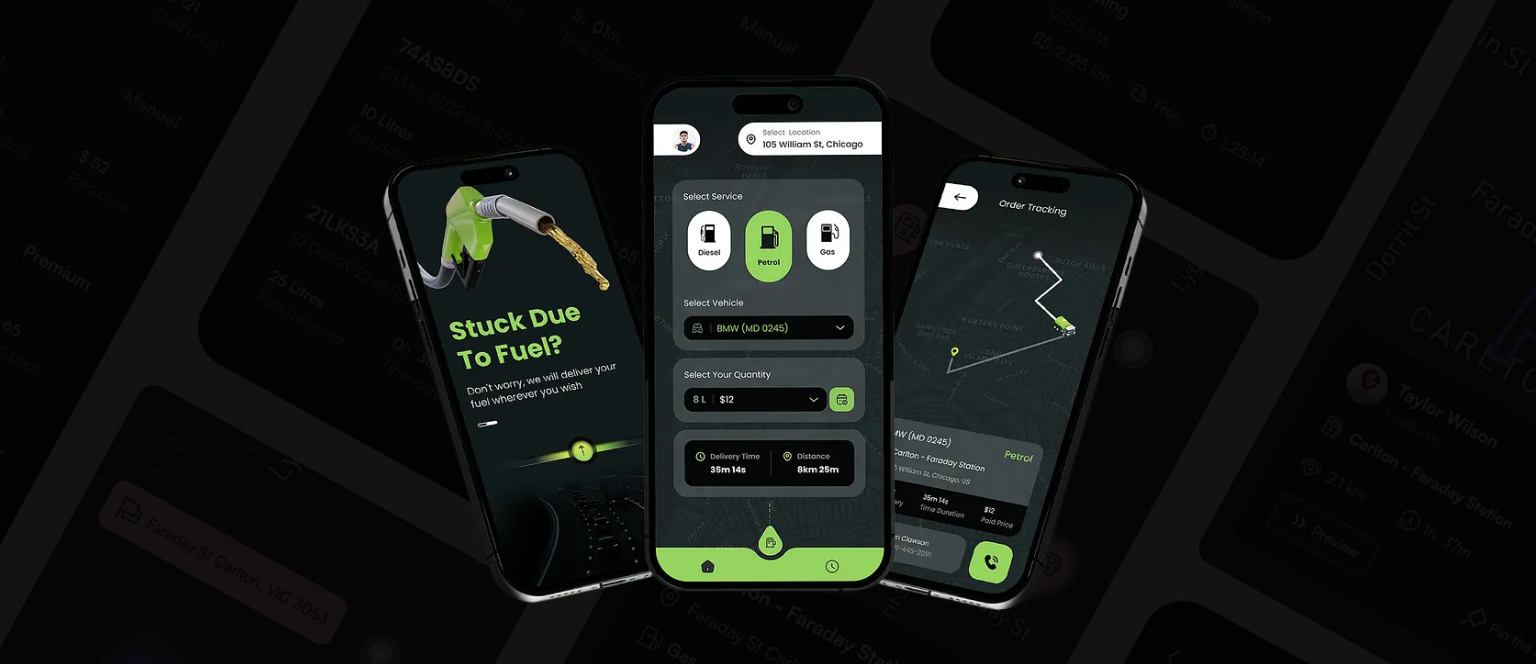Have you ever tried an app on your mobile which was not easy to use or had a confusing layout? Most likely, the app did not have a solid UI/UX design.
The design of UI/UX plays a crucial aspect in the performance of mobile applications. Customers expect a user-friendly and appealing interface, and when an app isn’t up to par in any one of the above areas, they’re likely to leave the app.
Here we’ll look at the significance of user interface (UI/UX) design in mobile applications. We will also assess its importance from both a developer’s and a user’s standpoint. Let’s begin
Table of Contents
Introduction to UI/UX Design and its Significance in Mobile App Development
UI/UX design is an integral element in mobile app development cycle that emphasizes both the experience of users (UX) and the user interface (UI) designs of an application. It plays an essential role in crafting mobile applications which are visually appealing while still user-friendly, giving customers an enjoyable user journey.
Here we will highlight the role UI/UX design plays in mobile app development and why companies must allocate sufficient funding towards this element of app creation.
Significance
-– UIUX design is essential to creating successful mobile apps. UIUX design encompasses creating the interface and overall user experience. A successful UIUX can make all the difference to its popularity as it will attract and keep users.
— An intuitive UIUX design can make an app more user-friendly and straightforward for its users, helping them quickly locate what they’re searching for in an effortless manner – this increases engagement, retention, and satisfaction levels across the board!
— User interface and experience design (UI/UX design) is an invaluable way for companies to distinguish themselves from rivals in a crowded marketplace of apps. A properly executed UIUX can set an app apart, making it more attractive and desirable among customers by employing distinctive design elements, intuitive navigation techniques, and providing user-centric services.
Bonus
- UIUX design can save businesses both time and money over the long term. When used properly, UIUX will reduce customer service needs while increasing user retention rates – saving companies both money and time in the form of lower customer support needs and customer retention rates. A well-designed UIUX will enable users to locate what they require quickly and efficiently while decreasing support needs, thus cutting customer support needs substantially in favor of faster user identification which reduces overall service needs for companies, in turn saving them both money and time.
- UIUX design can help businesses enhance their image. When done right, UIUX design will enhance brand perception while giving users a positive user experience – leading to improved loyalty from users as well as strengthening company recognition and building solid brand loyalty.
- UIUX design can help businesses increase revenue. A well-crafted UIUX can engage users and retain them more successfully, resulting in additional profits for companies as users who feel engaged will likely purchase in-app purchases and recommend your app more likely than those not engaged. Plus, they’re likely to return again and again!
- UIUX design can help businesses remain relevant in an ever-evolving marketplace, particularly mobile app markets that constantly evolve. A well-crafted UIUX will give its users an exceptional user experience that keeps pace with current market needs and trends.
The Role of UI/UX Design in Mobile App Development
UI/UX (User Interface and User Experience) design plays a crucial role in the development of mobile apps. Design and development of UIUX are the processes of developing a visually pleasing as well as user-friendly experience for digital products like mobile apps. This involves studying user behavior, creating intuitive user interfaces and optimizing the user experience. In the article, we’ll discuss the importance of UIUX design in the development of mobile apps and how it affects the performance of mobile apps.
UI/UX (User Interface and User Experience) Design plays an integral part in mobile app development. It involves crafting visually appealing yet user-friendly experiences for digital products like mobile apps. The UIUX design involves studying user behavior, designing intuitive user interfaces, and optimizing the user experience. In this article, we discuss its significance in mobile app creation as well as its effect on their performance.
1. Enhances User Engagement
One of the primary objectives in mobile app development is keeping users actively interested in its app, and UIUX design is one way to accomplish this objective by offering an inviting and user-friendly user interface that keeps people coming back. An appealing UIUX can reduce learning times for newcomers quickly while encouraging frequent usage as it generates positive emotions that prompt people to return again and again to use its services.
2. Improves User Retention
UIUX design plays a pivotal role in increasing retention in the mobile app industry. A complicated or confusing user experience could cause people to abandon an app in favor of another option, but an app with well-designed UIUX will create positive user experiences, which increases the chances of retention by keeping people involved with its platform.
3. Boosts App Downloads
The layout of a mobile application could affect the number of downloads it gets. A pleasing and user-friendly interface will attract potential users and convince them to download the application. However, poor design might turn away potential users, which can result in fewer downloads.
4. Increases Revenue
UIUX designs can affect the amount of revenue generated by mobile apps. An attractive interface will create an excellent user experience, which increases the probability that users purchase in-app purchases or sign up for features that are premium. However, an unprofessionally designed interface will deter users from spending money on the application.
5. Creates Brand Awareness
UI/UX design also impacts the perception of a brand. An appealing and user-friendly interface could make a positive impression on the brand, thereby increasing the chance that users will be able to remember the app and will recommend it to friends. However, poor design could create a negative perception of the company’s image, which can result in fewer recommendations and a decrease in the brand’s visibility.
Therefore, UIUX design plays a crucial role in mobile app development. It affects user engagement, retention and app downloads, as well as revenues and brand recognition. An attractive interface can provide an excellent user experience which can lead to greater success in the mobile app. This is why it is crucial for developers to put their money into UIUX creation and design when developing an app for mobile devices.
User Interface (UI) Design Elements for Mobile Apps
Mobile apps are now an integral aspect of the lives of many. The demands for mobile apps have been increasing over time which has made it essential for companies to have an app for mobile that is user-friendly, visually pleasing and efficient. The app’s design of user interface (UI) design plays an important role in the development and success of an app. We will then discuss some of the most important UI elements of design for mobile apps.
1. Navigation
Navigation is among the essential elements in the mobile application UI design. It is crucial to give users a simple and easy navigation system that directs them through the features and functions of the app. A simple and user-friendly navigation system can improve the user experience and improve the user experience of the app.
2. Consistency
Consistency is crucial in the design of mobile apps’ UI. The app must have an aesthetically consistent language comprising typography and colors along with visual and textual elements. A unifying design style aids users in comprehending the app’s functions and features and provides a sense of familiarity, which improves user experience.
3. Typography
Typography is an important aspect of a mobile app’s user interface design. The font size, typeface and color should be selected to ensure that the text is read. The font size must be adequate to be read on mobile devices, and the typeface must be clear. The text’s colour should be in contrast to the background to improve accessibility.
4. Visual Elements
Visual elements play an important aspect of the mobile application’s UI design. The design of the app’s visuals must be visually appealing and captivating. Utilizing images as icons, illustrations, and images can improve the user experience and help make the app more visually attractive. Visual elements should be consistent throughout the application.
5. User Feedback
Feedback from users is an important aspect of a mobile app’s UI design. The app must give users feedback every time they use the app’s capabilities and features. Feedback could be given via sounds, animations, or tactile feedback. Feedback from users helps users comprehend the app’s functions and features and helps create a sense of involvement.
6. Gestures
Gestures are an important part of the mobile app’s UI design. The app must use gestures that are simple and simple to use. The most common gestures are swiping, pinching, tapping, and dragging. Gestures can improve the users’ experience by providing them with a natural and intuitive method of interacting with the application.
7. App UX Design
Application UX Design is the method of defining the user experience of an app. It is about understanding the requirements of users and developing the app’s functions and features to meet these requirements. App UX design must be based on user research and tests to ensure that the app is able to meet the requirements of the user and delivers the best user experience.
Thus, it is true that mobile app UI design is vital to designing a user-friendly and visually pleasing, and practical application. Typography, consistency, navigation elements of visual design, feedback from users’ gestures, as well as app UX design are the most important elements of UI design for mobile applications. Companies looking to create an app for mobile should partner with a UI development company that knows these aspects and is able to develop an app that is compatible with the requirements of their customers and delivers users a great experience.
Want to build a Solid UI/UX design for your App?
Choose A3logics as your mobile app development company with 20 years of experience in building great apps
User Experience (UX) Design Elements for Mobile Apps
Apps for mobile have been a fundamental element of our lives. From entertainment to communication, from shopping to banking, there’s an app for everything. With the ever-growing competition in the mobile application market, it’s essential to offer users a smooth and enjoyable experience. This is where the mobile UI/UX design is a key factor. In the article below, we’ll look at some of the main aspects of user experience design for mobile apps.
-
Simple and intuitive navigation:
The navigation menu is among the most crucial elements of designing the user experience for mobile apps. The navigation menu needs to be easy and simple to navigate, allowing users to effortlessly navigate between various sections within the application. The menus for navigation must be consistent across the app, giving users a feeling of familiarity and ease.
-
Friendly user interface:
A friendly interface is crucial for the design of mobile apps’ user experience. The interface must be attractive and simple to navigate and include simple and clear instructions. The interface must also be fluid with elements that are simple to touch and interact with.
-
Consistency in Design:
Consistency in Design is essential for mobile app user experience design. The design must be uniform across every screen and section of the app. This includes the same colours, font styles and layout. This provides a feeling of familiarity and ease for users, which makes it easier for them to use the application.
-
Fast loading times:
Mobile apps should be able to load quickly and effectively. Long loading times can cause frustration and even abandonment. Designing the user experience for mobile apps should be focused on optimizing the app to ensure speedy loading, cutting down on the size of videos and images and reducing the amount of HTTP requests.
-
Personalization:
It is an essential component of the design of mobile apps’ user experience. The app must be adapted to the preferences and requirements of the user, offering personalized information and suggestions. This builds a sense of the relationship between the users and the app, which increases the user’s engagement and loyalty.
-
Feedback and error messages:
Error and feedback messages are vital to designing the user experience for mobile apps. The app should give precise and concise feedback to users once they’ve completed an action, advising users of any errors or problems. This aids users in understanding the issue and how to fix it.
-
Accessibility:
The mobile user experience design for apps must also consider accessibility. The app should be developed to be able to use by disabled users and include features such as text-to-speech and high-contrast mode. This will ensure that everyone has access to and use of the app regardless of their ability.
Therefore, designing for mobile UX/UI is vital to provide an effortless and enjoyable user experience. Simple and easy navigation, an intuitive interface, consistent design, speedy loading times, personalized feedback, individualization, errors, as well as accessibility are all essential aspects of the user experience of mobile apps. If they concentrate on the above aspects, mobile app developers are able to develop apps that are enjoyable and user-friendly. They can also be effective in the highly competitive market for mobile apps.
The Importance of User Testing for UI/UX Design in Mobile App Development
User testing is an integral component of the UI/UX design process for developing mobile apps for customers. It involves studying and analyzing how users use the app in order to discover bugs in the design, usability issues and areas that could be improved. The knowledge obtained from user testing could assist designers in developing applications that are user-friendly as well as user-friendly and that are able to meet the needs of the intended audience. In this article, we’ll discuss the importance of testing with users in UI and UX design for mobile application development.
1. Enhances User Experience
The testing of users is essential to making sure the mobile app is simple to use and navigate. By watching how users interact through the app, designers are able to identify points of confusion or discontent and make the appropriate adjustments to enhance the user experience overall. This could include reducing the app’s layout, increasing the clarity of directions and decreasing the number of steps needed to finish an action.
2. Identifies Design Flaws
Tests with users help designers spot weaknesses in their designs that might not be obvious at first. For instance, users might be unable to locate a specific feature or purpose, or the app’s color scheme might be difficult to comprehend for certain users. This can be resolved by conducting user tests that can make sure that your app is user-friendly and works as intended.
3. Saves Time and Money
Testing user interfaces will save time and cash in the end by identifying issues that could be present during the process of designing. By identifying design flaws and usability issues in the early stages, designers can make necessary adjustments before the application launches. This will help avoid costly revisions and updates later on in the road, which could be costly and time-consuming.
4. Increases User Engagement
Testing user behavior helps designers develop an app that’s engaging and draws users back. By observing how users interact using the app, developers can determine the features and functions that users find appealing and then adjust the app to suit their preferences. This will help improve user engagement, which will increase retention rates and higher revenues.
5. Provides Valuable Feedback
Tests by users provide useful feedback from actual users. It helps designers to understand how their application is perceived by the users they intend to target. This information is used to make more informed design decisions and enhance your overall experience for users. Furthermore, user testing can reveal any holes in the application’s capabilities or features that users might be seeking.
Therefore, testing user behavior is a crucial component of the UX/UI process of design in the development of mobile apps that are custom. It offers designers invaluable insight into how users use the app. It can also help determine the design flaws, usability issues and areas for improvement. When including user testing in the process of designing, designers can design applications that are user-friendly, easy to use, user-friendly, and that fulfil the needs of the audience they are targeting. In the end, this could result in higher engagement with users and revenue growth, as well as a more effective mobile app.
Final Thoughts
In the end, UI/UX design plays an important role in the achievement of custom mobile app development. A well-designed UI/UX will enhance user experience, boost engagement, boost retention and boost revenue. It is crucial to invest in UI/UX design so that your mobile application stands out from your crowd and is able to meet the demands of your users. By paying attention to the user’s experience and creating an easy, user-friendly and visually appealing interface, you will be able to develop a mobile application that users enjoy and want to return to. The end result is that UI/UX design should be not just a nice thing to have but an essential component for any successful custom mobile development company project.






